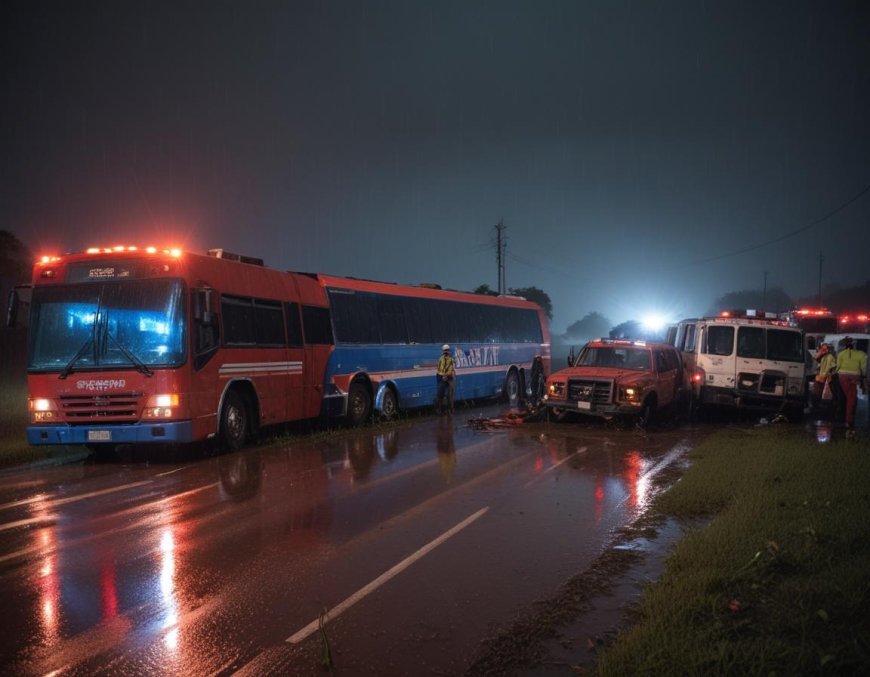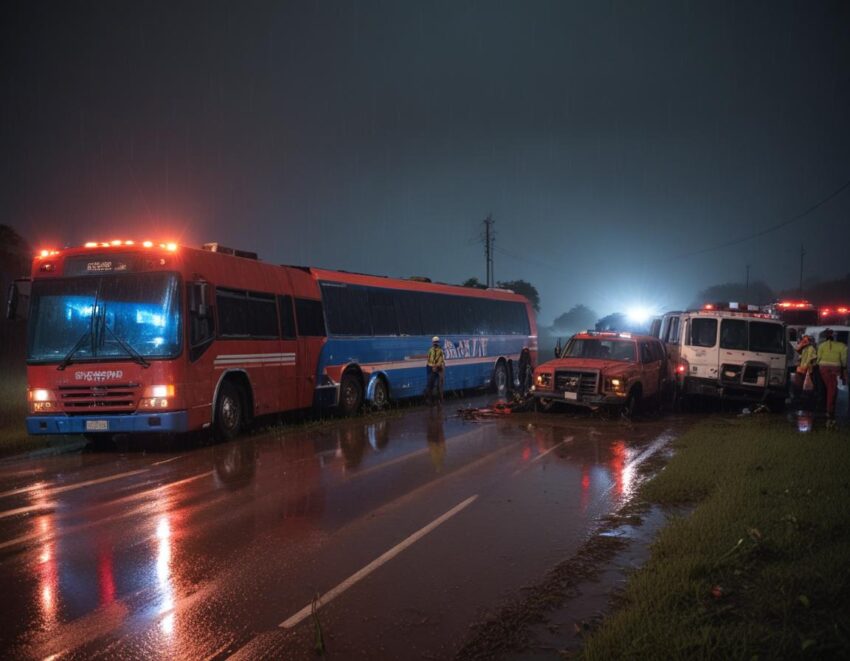Brazil Bus-Truck Collision in Mato Grosso Leaves Eleven Dead, Forty-Five Injured in Devastating Crash


Brazil Bus-Truck Collision in Mato Grosso Leaves Eleven Dead, Forty-Five Injured in Devastating Crash — This tragic headline became a grim reality late Friday night in the centre-western Brazilian state of Mato Grosso. The devastating crash between a passenger bus and a cottonseed-laden truck near Lucas do Rio Verde has left the nation in shock. In this Brazil bus-truck collision, emergency responders confirmed that eleven people tragically lost their lives, while forty-five others sustained injuries of varying severity. Among them, several remain in critical condition. The Mato Grosso accident scene was marked by twisted metal, shattered glass, and the urgency of rescue crews working through the night. This devastating crash underscores the vulnerability of long-distance travellers on Brazil’s highways, where heavy vehicles and passenger transport often share narrow lanes. The incident is now under investigation, with authorities seeking answers to prevent another Brazil bus-truck collision of this scale.
Mato Grosso is one of Brazil’s most exciting and diverse states. It is home to wetlands, waterfalls, clear rivers, and the edge of the Amazon rainforest. Visitors can see jaguars, snorkel in spring-fed streams, and hike to towering falls. This mix of nature and culture makes Mato Grosso a true adventure for travellers.
Deadly Collision Shocks Mato Grosso
Late on Friday, at around 9:40 p.m. local time, a bus carrying dozens of passengers crashed into a truck transporting cottonseed. The accident happened near Lucas do Rio Verde, a key agricultural hub in Brazil’s centre-west region. Officials confirmed that the impact was severe, instantly claiming multiple lives. The crash site quickly turned chaotic as emergency teams fought to rescue survivors and clear the wreckage.
Victims and Emergency Response
According to Brazil’s federal highway police and toll road operator Nova Rota do Oeste, 11 passengers died on the spot. Forty-five others were injured and transported to nearby hospitals. Medical reports indicate that 11 are in critical condition, 26 have moderate injuries, and 8 suffered only minor wounds. Emergency crews worked under pressure, using hydraulic tools to free trapped victims from the mangled bus.
Eyewitness Accounts from the Scene
Local witnesses described a harrowing scene, with debris scattered across the road and the strong smell of diesel in the air. Some passengers managed to escape through shattered windows, while others were pulled out by rescuers. “It was terrifying — people were screaming and calling for help,” said one survivor. Rescue helicopters and ambulances transported the most severely injured to regional hospitals.
Investigation into the Cause
Authorities have yet to determine the exact cause of the crash. Initial reports suggest a head-on collision, but investigators are analysing skid marks, vehicle conditions, and possible driver fatigue. The truck was carrying a heavy load of cottonseed, which spilled across the road, making recovery efforts even more challenging. Weather conditions at the time were reported as clear, ruling out rain or fog as immediate factors.
The Road Safety Context in Brazil
Brazil’s highways, especially in agricultural transport zones like Mato Grosso, often witness deadly collisions. Heavy truck traffic, long travel distances, and driver fatigue contribute to the high accident rates. Official statistics show that thousands die annually in road crashes, making road safety a persistent national concern. The government has been under pressure to improve enforcement and infrastructure in high-risk regions.
Lucas do Rio Verde’s Strategic Importance
Lucas do Rio Verde is not only a major farming town but also a critical point in Brazil’s road transport network. The region sees constant truck and bus movement, connecting rural areas to major cities and ports. The high volume of heavy vehicle traffic increases the risk of severe accidents, making this tragedy a grim reminder of the dangers faced daily by travellers and drivers alike.
Emergency Services Coordination
Nova Rota do Oeste, which manages the toll road where the crash occurred, coordinated with federal highway police to secure the area. Firefighters, paramedics, and police officers worked in synchrony to treat the injured and redirect traffic. Nearby hospitals activated emergency protocols to handle the sudden influx of patients, prioritising critical cases for surgery and intensive care.
Humanitarian Support and Victim Assistance
Local authorities have set up support centres for families of the victims. Counsellors and volunteers are providing psychological assistance, while community members have started donation drives for medical supplies and blood. The tragedy has united residents in grief and solidarity, with vigils planned in several towns to honour the victims.
Government and Public Reaction
The accident has sparked public outrage over road safety standards. Politicians have called for urgent action, including stricter driving hour regulations, improved road lighting, and more frequent safety inspections for commercial vehicles. The Ministry of Transport has pledged a full investigation and promised to review policies that could prevent such large-scale accidents in the future.
Broader Impact on Regional Transport
The collision temporarily disrupted traffic on the key highway, causing delays for commercial transport. Agricultural exporters, dependent on timely deliveries, faced logistical setbacks. The road has since been cleared, but the incident highlights the vulnerability of Brazil’s freight and passenger transport system to sudden disasters.
A National Wake-Up Call
For many in Brazil, this tragedy is a stark reminder that road travel remains a risky endeavour, especially in rural regions. Experts say that without stronger enforcement of speed limits, driver rest periods, and vehicle maintenance standards, similar disasters will continue. The loss of life in Mato Grosso is a painful call for reform.
The Pantanal – Home of the Jaguar
The Pantanal in Mato Grosso is the largest tropical wetland in the world. It is famous for its wildlife. Travellers can take boat trips from Porto Jofre to see jaguars on the riverbanks. Other animals include giant otters, capybaras, and caimans.
The best time to visit is the dry season from June to November. Water levels drop and animals gather near rivers, making them easier to spot. The main road to reach the Pantanal is the Transpantaneira. It is 147 kilometres long and crosses over 120 wooden bridges. Along the way, you can see birds, deer, and reptiles in their natural home.
Chapada dos Guimarães – Land of Waterfalls
Chapada dos Guimarães National Park is close to Cuiabá, the state capital. It has high cliffs, deep valleys, and many waterfalls. The most famous is the Véu de Noiva, or Bride’s Veil, which drops almost 90 metres into a green canyon.
Hiking trails lead to smaller falls and natural pools. The Waterfalls Circuit is an 8-kilometre route that takes you past many scenic spots. Guides are required for safety and to protect the park. This region is also known for its rich plant and bird life.
Nobres – Brazil’s Crystal-Clear Rivers
Nobres, especially the Bom Jardim district, is a paradise for water lovers. Its rivers and springs are so clear that you can see fish swimming below. Popular sites include the Aquário Encantado and Rio Triste, where visitors snorkel with colourful fish.
Another highlight is Lagoa das Araras, a lake where macaws gather at sunset. Nobres is often compared to Bonito, but it is quieter and less crowded. Activities are managed carefully to keep the water clean and wildlife safe.
Edge of the Amazon – Alta Floresta
Alta Floresta is in the north of Mato Grosso and is a gateway to the Amazon rainforest. Cristalino State Park here is known for birdwatching, with nearly 600 species recorded. Visitors can climb canopy towers to see the forest from above or paddle through black-water rivers.
Cristalino Lodge offers guided trips, making it easy to explore the forest without harming it. This area is perfect for travellers who want a rainforest experience without long journeys deeper into the Amazon.
A Destination for All Seasons
Mato Grosso offers different highlights at different times of the year. The dry season is best for spotting wildlife in the Pantanal. Cooler months are great for hiking in Chapada dos Guimarães. Nobres is perfect in the dry season when water visibility is highest.
With its mix of wetlands, rivers, cliffs, and rainforest, Mato Grosso is one of Brazil’s most thrilling destinations. It offers adventures for nature lovers, photographers, and families alike.
Conclusion: A Call for Safer Roads
The Mato Grosso bus-truck collision has left deep scars on the community of Lucas do Rio Verde and the entire nation. As families mourn and survivors recover, the focus now turns to preventing another tragedy. Stronger safety rules, better road design, and nationwide awareness campaigns may be the only way to make Brazil’s highways safer for everyone.
The post Brazil Bus-Truck Collision in Mato Grosso Leaves Eleven Dead, Forty-Five Injured in Devastating Crash appeared first on Travel And Tour World.






